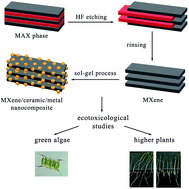Influence of modification of Ti3C2 MXene with ceramic oxide and noble metal nanoparticles on its antimicrobial properties and ecotoxicity towards selected algae and higher plants†
Abstract
The number of investigations regarding the application of 2D nanosheets of MXenes in different technological areas is growing rapidly. Different surface modifications of MXenes have been introduced to date in order to tailor their properties. As a result, surface-modified MXenes could be released in the environment from filtration membranes, adsorbents, or photocatalysts. On the other hand, assessment of their environmental impact is practically unexplored. In the present study, we examined how modification of the antimicrobial Ti3C2 MXene with ceramic oxide and noble metal nanoparticles affects its toxic behavior. The expanded 2D sheets of the Ti3C2 MXene phase were modified with Al2O3/Ag, SiO2/Ag, and SiO2/Pd nanoparticles using the sol–gel method and extensively characterized. The obtained 2D nanocomposite structures were characterized by antibacterial properties. The ecotoxicological assays considered green algae (Desmodesmus quadricauda) as well as two higher plants: sorghum (Sorghum saccharatum) and charlock (Sinapis alba). Our results revealed that obtained nanomaterials can cause both stimulating and inhibiting effects towards algae, and the ecotoxicity depended on the concentration and the type of modification. The study reveals the intriguing property of pristine Ti3C2 which highly stimulated green algae growth at low concentrations. It also shows that modification of pristine Ti3C2 MXene with different nanoparticles changes the ecotoxicological effects of the resulting nanocomposite 2D structures. We have also indicated nanocomposite structures that does not revealed the toxic effect on tested organisms i.e. the Ti3C2 MXene surface-modified with Al2O3/Ag was not phyto- and eco-toxic. This work helps with better understanding of the reactivity of surface-modified MXenes towards chosen organisms, giving more information concerning the potential impact of tested nanocomposites on the ecosystems.



 Please wait while we load your content...
Please wait while we load your content...